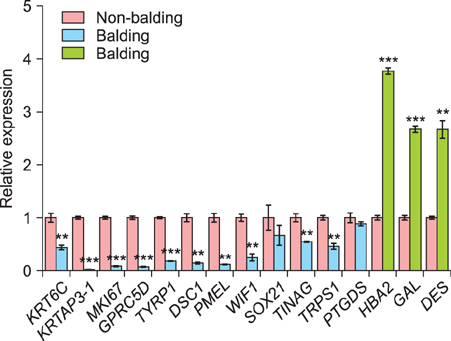Ann Dermatol.
2017 Oct;29(5):597-601. 10.5021/ad.2017.29.5.597.
Comprehensive Transcriptome Profiling of Balding and Non-Balding Scalps in Trichorhinophalangeal Syndrome Type I Patient
- Affiliations
-
- 1TheragenETEX Bio Institute, TheragenETEX Inc., Suwon, Korea.
- 2Department of Nanobiomedical Science, Dankook University, Cheonan, Korea.
- 3BK21 PLUS NBM Global Research Center for Regenerative Medicine, Dankook University, Cheonan, Korea.
- 4DKU-Theragen Institute for NGS Analysis (DTiNa), Dankook University Medical College, Cheonan, Korea.
- 5Department of Dermatology, Dankook University Medical College, Cheonan, Korea. 4exodus@dankook.ac.kr
- KMID: 2388911
- DOI: http://doi.org/10.5021/ad.2017.29.5.597
Abstract
- BACKGROUND
Trichorhinophalangeal syndrome (TRPS) patients tend to have alopecia that appears to be androgenetic, and this genetic model might give clues to the pathogenesis of hair loss or hair morphogenesis.
OBJECTIVE
This study was conducted to identify additional genetic evidence of TRPS and hair morphogenesis from a TRPS patient.
METHODS
From one TRPS type I patient, we extracted RNA and profiled whole transcriptome in non-balding and balding scalp areas using high-throughput RNA sequencing.
RESULTS
We found a total of 26,320 genes, which comprised 14,892 known genes with new isoforms and 4,883 novel genes from the non-balding and balding areas. Among these, a total of 1,242 genes showed different expression in the two scalp areas (p<0.05 and log2 fold-change >0). Several genes related to the skin and hair, alopecia, and the TRPS1 gene were validated by qRT-PCR. Twelve of 15 genes (KRT6C, KRTAP3-1, MKI67, GPRC5D, TYRP1, DSC1, PMEL, WIF1, SOX21, TINAG, PTGDS, and TRPS1) were down-regulated (10 genes: p<0.01; SOX21 and PTGDS: p>0.05), and the three other genes (HBA2, GAL, and DES) were up-regulated (p<0.01) in the balding scalp. Many genes related to keratin and hair development were down-regulated in the balding scalp of the TRPS type I patient. In particular, the TRPS1 gene might be related to androgen metabolism and hair morphogenesis.
CONCLUSION
Our result could suggest a novel perspective and evidence to support further study of TRPS and hair morphogenesis.
Keyword
MeSH Terms
Figure
Reference
-
1. Fantauzzo KA, Christiano AM. Trps1 activates a network of secreted Wnt inhibitors and transcription factors crucial to vibrissa follicle morphogenesis. Development. 2012; 139:203–214.
Article2. Shimomura Y, Agalliu D, Vonica A, Luria V, Wajid M, Baumer A, et al. APCDD1 is a novel Wnt inhibitor mutated in hereditary hypotrichosis simplex. Nature. 2010; 464:1043–1047.
Article3. Trapnell C, Williams BA, Pertea G, Mortazavi A, Kwan G, van Baren MJ, et al. Transcript assembly and quantification by RNA-Seq reveals unannotated transcripts and isoform switching during cell differentiation. Nat Biotechnol. 2010; 28:511–515.
Article4. Flicek P, Ahmed I, Amode MR, Barrell D, Beal K, Brent S, et al. Ensembl 2013. Nucleic Acids Res. 2013; 41(Database issue):D48–D55.5. Anders S, Pyl PT, Huber W. HTSeq--a Python framework to work with high-throughput sequencing data. Bioinformatics. 2015; 31:166–169.
Article6. Sun J, Nishiyama T, Shimizu K, Kadota K. TCC: an R package for comparing tag count data with robust normalization strategies. BMC Bioinformatics. 2013; 14:219.
Article7. Morris RJ, Liu Y, Marles L, Yang Z, Trempus C, Li S, et al. Capturing and profiling adult hair follicle stem cells. Nat Biotechnol. 2004; 22:411–417.
Article8. Malik TH, Von Stechow D, Bronson RT, Shivdasani RA. Deletion of the GATA domain of TRPS1 causes an absence of facial hair and provides new insights into the bone disorder in inherited tricho-rhino-phalangeal syndromes. Mol Cell Biol. 2002; 22:8592–8600.
Article9. Gai Z, Gui T, Muragaki Y. The function of TRPS1 in the development and differentiation of bone, kidney, and hair follicles. Histol Histopathol. 2011; 26:915–921.10. Chang GT, Jhamai M, van Weerden WM, Jenster G, Brinkmann AO. The TRPS1 transcription factor: androgenic regulation in prostate cancer and high expression in breast cancer. Endocr Relat Cancer. 2004; 11:815–822.
Article11. Gao Y, Wang X, Yan H, Zeng J, Ma S, Niu Y, et al. Comparative transcriptome analysis of fetal skin reveals key genes related to hair follicle morphogenesis in cashmere goats. PLoS One. 2016; 11:e0151118.
Article12. Kiso M, Tanaka S, Saba R, Matsuda S, Shimizu A, Ohyama M, et al. The disruption of Sox21-mediated hair shaft cuticle differentiation causes cyclic alopecia in mice. Proc Natl Acad Sci U S A. 2009; 106:9292–9297.
Article13. Garza LA, Liu Y, Yang Z, Alagesan B, Lawson JA, Norberg SM, et al. Prostaglandin D2 inhibits hair growth and is elevated in bald scalp of men with androgenetic alopecia. Sci Transl Med. 2012; 4:126ra34.



